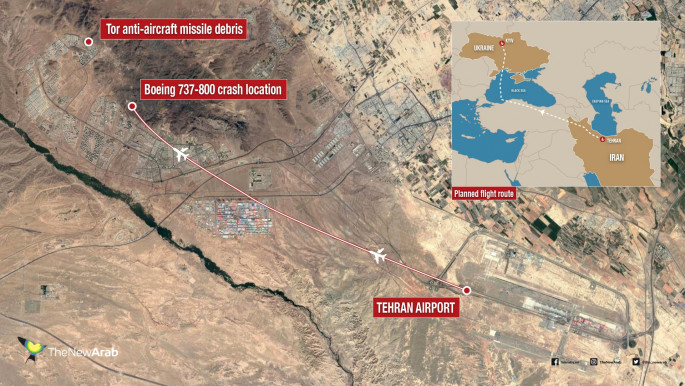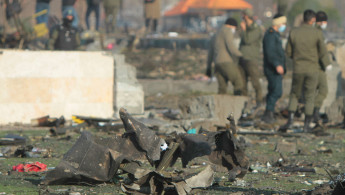Missile attack or engine failure? The possible causes of the Iran plane crash explained
Despite initial reports of an engine failure, the timing of the disaster - in the midst of the highest US-Iran tensions in decades - immediately sparked speculation of foul play.
The Iranian aviation body's preliminary probe affirmed there was a "problem" that caused the Boeing 737 to turn back just after take off, and disappeared from radars at an altitude of 2,400 metres (8,000 feet). The crew sent no message about an emergency, it added.
However the organisation said, as eyewitnesses have also confirmed, the plane was on fire before it crashed.
Iran's state media has attributed the crash to "technical difficulties".
Read more: Why did Iran target US troops at Iraq's Ain al-Asad, a sprawling Saddam-era military base?
Speculation heightened after Ukraine retracted its initial statement confirming engine failure as the cause of the crash.
Instead, it sent a team of 45 crash investigators to Iran for further investigations, including an assessment of the two retrieved black boxes, and announcing it was pursuing several possible leads in relation to the crash, including a surface-to-air missile strike, a terrorist attack, or collision with another airborne object, as well as engine failure.
Some of the investigators include experts who took part in the review of the 2014 Malaysian Airlines flight MH17, which was suspected of being shot down by pro-Russia rebels over Ukraine, killing all 298 people on board.
To stoke speculation further, US officials waded into the debate on Thursday to say they were "confident" the jet was shot down "mistakenly" by Iran.
Their announcement came shortly after the UK announced it was looking into "very concerning" reports, with Prime Minister Boris Johnson calling for a "full, credible and transparent" probe.
| |
Three Brits, along with 82 Iranians, 63 Canadians, 10 Swedes, four Afghans, three Germans and 11 Ukrainians, including nine crew, lost their lives in the disaster, according to Ukrainian figures.
Diplomatic tensions are also threatening to obstruct a smooth investigation into the crash, with probes into such incidents long and complex and requiring intense cooperation across jurisdictions - in this case Iran, Ukraine and Boeing manufacturer, the US.
Iran has said it will not hand the plane's black boxes to the US - a country it has had no diplomatic relations with since 1979 - but was willing to cooperate with Ukraine.
While the world awaits the final results of the lengthy investigation, we dive into the two key leads of Wednesday's tragedy.
Missile attack
Several threads point to a scenario in which Iranian air defence missiles downed the passenger jet by mistake.
Twitter Post
|
The theory was firstly stoked by the alleged discovery of a Russian-made "Tor" anti-aircraft missile near the site of the crash. Although the finding is yet to be confirmed, it was cited by the Ukrainian authorities as they announced further investigations.
Images purported to be of the missile are being looked into by open-source research firm Bellingcat, who stressed the difficulty in verifying and geolocating the images, while manipulated versions began circulating online.
Secondly, an independent aviation authority OPSGROUP published a report on the images of the Boeing wreckage, claiming the fuselage shows "obvious projectile holes".
Making a bold claim, the group said they recommended the "starting assumption to be that this was a shootdown event, similar to MH17 - until there is clear evidence to the contrary", while admitting its assessment relied on significant conjecture.
A third indicator of a missile explanation comes from anonymous crewmembers of a plane flying nearby the Ukrainian Boeing, who reported witnessing a fire onboard that could only have been caused by a shooting or bombing.
The theory gained further traction after an unverified video claiming to show the plane crashing while engulfed in flames.
Twitter Post
|
The missile theory has, however, attracted significant pushback from a range of analysts.
Bellingcat founder Elliot Higgins cautioned that his team had seen "nothing yet" to "indicate it was anything but an accident".
Some analysts have pointed to apparent holes in the fuselage as shrapnel damage, Higgins added.
"We saw the same thing happen with MH17, mud and rocks in low resolution photographs being wrongly identified as shrapnel damage, led some people to make early, faulty, conclusions about the wreckage, and the same is happening here," he said in a tweet.
Speaking to The Independent, Philip Baum, the editor of Aviation Security International magazine, said it was too early to speculate about the crash.
"Given the fact it was in Iran and the timing, and if you associate two states with shootdowns, as victims, then Ukraine springs to mind purely because of MH17," and Iran, due to the 1988 US shooting down of an Iranian civilian plane, he said.
"I just think there is nothing to indicate that it was a shootdown, and if it was shot down then by whom?"
Engine failure
Speaking to The Times, pilot Charles Bremner highlighted the key lead in regards to the engine failure theory.
Twitter Post
|
"A fan blade or other fast-rotating part may have sheared off in one of the two Boeing 737 engines," he said.
Take-off is known to be the most dangerous time for engine failure.
"Shrapnel from the engine casing could rupture fuel tanks, causing fire and disrupting the controls and electrical circuits," he added.
The video of the blazing plane circulating social media could also be consistent with engine failure, as it sows flames emerging from the plane wing and engine casing found on the ground with holes thought to be made from a foreign object entering the engine.
Initial Iranian reports alluded to its history of aviation disasters put down to US sanctions that preventing Iran’s fleet from vital updates and leaving them prone to mechanical and engine failures.
Nearly 2,000 Iranians have died in plane crashes since 1979, however, the Boeing jet being Ukrainian, this argument doesn’t stand to reason.
Diplomatic tensions
In the current fog of proxy war between the US, Iran and their allies, many are sceptical of a clear outcome of the various investigations.
Rumours circulated on Thursday of various foul play by the Iranians, including the crash site being bulldozed and the Twitter account of an eyewitness being deleted, however most reports remain social media speculation.
Read more: A decades-long battle: The Iran-US rivalry explained
It also remains undecided where the black boxes will go for investigation, as Iran has already ruled out the custom protocol of the manufacturer carrying out an investigation in the event of engine or mechanical failure.
Few countries - the UK, France, Germany and the US - are capable of analysing black box data, but Iran is yet to reach out.
If the past months of posturing and saving face between Iran and the US are anything to go by, the truth of what happened to the Ukrainian jet and its 176 passengers will be hard-won.
Follow us on Twitter and Instagram to stay connected





 Follow the Middle East's top stories in English at The New Arab on Google News
Follow the Middle East's top stories in English at The New Arab on Google News


